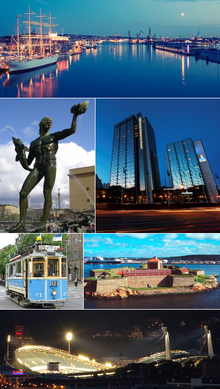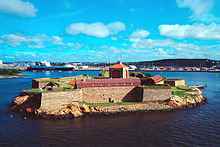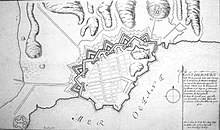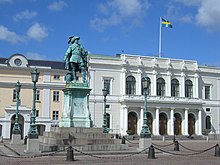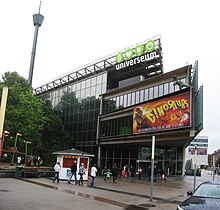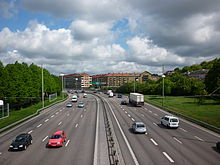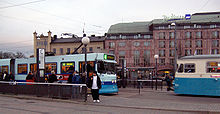Gothenburg
| Gothenburg | ||||
|
||||
| State : | Sweden | |||
|
Provinces (län): |
Västra Götalands län Hallands län |
|||
| Historical provinces (landskap): |
Västergötland Bohuslän Halland |
|||
|
Municipalities : |
Gothenburg Kungsbacka Mölndal Partille |
|||
| Coordinates : | 57 ° 42 ' N , 11 ° 57' E | |||
| SCB code : | 4368 | |||
| Status: | Crime scene | |||
| Residents : | 572,799 (December 31, 2015) | |||
| Area : | 215.13 km² | |||
| Population density : | 2663 inhabitants / km² | |||
| Height : | 15 m ö.h. | |||
| Postal code : | 400 10-418 79 | |||
| List of perpetrators in Västra Götaland County | ||||
(Swedish [ ˌʝœtəˈbɔrj ] ; German outdatedGotenburgorGothenburg; LatinGothoburgum, EnglishGothenburg, DanishGøteborg) is acityin theSwedishprovinces ofVästra Götalands län, of which it is the residence, andHallands länas well as thehistorical provincesVästergötland,BohuslänandHalland.
Gothenburg is the second largest city in Sweden after Stockholm and before Malmö ; same ranking also takes Storgöteborg ( "Greater Gothenburg") above, 13 municipalities comprehensive metropolitan area a population of 993,453 (September 30 2016). The city is divided into ten districts .
geography
The university town is located on the west coast of Sweden on both sides of the main arm of the Göta älv river , which flows into the Kattegat there . The districts north of the river are on the island of Hisingen between Göta älv and its right arm Nordre älv, the fourth largest and most populous island in Sweden.
Compared to Stockholm, for example, Gothenburg has a more favorable climate and offers with its ice-free seaport in the mouth of the Göta älv a significant economic advantage (heavy industry and ferry traffic).
In front of the city in the Kattegat is the Gothenburg archipelago (skärgård) with small and tiny rocky archipelago islands , some of which are inhabited.
Gothenburg is the capital of the municipality of Gothenburg from Västra Götalands län, which does not include the entire city area. This contiguous built-up area, the Gothenburg crime scene , is 80% of the inhabitants on the territory of the municipality of Gothenburg (457,927 inhabitants on 145.39 km²). Smaller parts of the crime scene include parts of the surrounding municipalities Mölndal (39.35 km², 60,513 inhabitants, 11%), Partille (12.26 km², 30,425 inhabitants, 5%, both Västra Götalands län) and Kungsbacka (18.14 km², 23,934 Inhabitants, 4%, Halland County). On the other hand, parts of the municipality do not belong to the Gothenburg crime scene, in particular the 2015 newly identified crime scene Björlanda och Torslanda (23,088 inhabitants) on Hisingen and Gunnared och Hammarkullen (45,106 inhabitants) in the north-east of the city, December 2015).
The north-western districts on the island of Hisingen belong to the historical province (landskap) Bohuslän , while the central and eastern areas are in Västergötland . By assigning the previously independent crime scene Kungsbacka , Lindome and a few smaller ones to the crime scene Göteborg 2015, this now not only extends into the province of Halland County, but also into the Landskap Halland , making Gothenburg the only place in Sweden in three historical provinces.
In addition to the municipality of Göteborg and the entire territories of the municipalities Kungsbacka, Mölndal and Partille, the metropolitan region also includes the nine other surrounding municipalities Ale , Alingsås , Härryda , Kungälv , Lerum , Lilla Edet , Öckerö , Stenungsund and Tjörn , apart from the municipality of Kungsbacka (Hallands län) all in the province of Västra Götalands län.
The city of Gothenburg has been divided into 10 municipal districts within the municipal boundaries since January 1, 2011, which were created through partial amalgamation of the 21 municipal districts that have existed since 1989. The city districts ( stadsdelsnämnder, literally "district councils ") are further subdivided into a total of 96 primary areas (primärområden) .
The ten city districts with their associated primary areas are (residents as of December 31, 2015):
- Angered (formed from Gunnared and Lärjedalen, 51,214 inhabitants):
- Agnesberg, Angereds Centrum, Bergum, Eriksbo, Gårdstensberget, Gunnilse, Hammarkullen, Hjällbo, Linnarhult, Lövgärdet, Rannebergen (11)
- Askim-Frölunda-Högsbo (formed from Askim, Frölunda and Högsbo, 58,148 inhabitants):
- Askim, Billdal, Flatås, Frölunda Torg, Hovås, Högsbo, Högsbohöjd, Högsbotorp, Järnbrott, Kaverös, Ruddalen, Tofta (12)
- Centrum (60,512 inhabitants):
- Guldheden, Heden, Inom Vallgraven, Johanneberg, Krokslätt, Landala, Lorensberg, Stampen, Vasastaden (9)
- Lundby (49,875 inhabitants):
- Eriksberg, Kärrdalen, Kvillebäcken, Kyrkbyn, Lindholmen, Rambergsstaden, Slättadamm (7)
- Majorna-Linné (formed from Linnéstaden and Majorna, 63,729 inhabitants):
- Änggården, Annedal, Haga, Kungsladugård, Majorna, Masthugget, Olivedal, Sanna, Stigberget (9)
- Norra Hisingen (previously Backa, Kärra-Rödbo and Tuve-Säve, 49,529 inhabitants):
- Backa, Brunnsbo, Kärra, Rödbo, Skogome, Säve, Skelltorp, Tuve (8)
- Örgryte-Härlanda (previously Härlanda and Örgryte, 58,430 inhabitants):
- Bagaregården, Björkekärr, Härlanda, Kallebäck, Kålltorp, Kärralund, Lunden, Olskroken, Överås, Redbergslid, Skår, Torpa (12)
- Östra Göteborg (previously Bergsjön and Kortedala, 48,274 inhabitants):
- Gamlestaden, Norra Kortedala, Östra Bergsjön, Södra Kortedala, Utby, Västra Bergsjön (6)
- Västra Göteborg (previously Älvsborg, Södra Skärgården and Tynnered, 52,740 inhabitants):
- Ängås, Bratthammar, Fiskebäck, Grevegården, Grimmered, Guldringen, Hagen, Kannebäck, Långedrag, Näset, Önnered, Södra Skärgården, Skattegården (13)
- Västra Hisingen (previously Biskopsgården and Torslanda, 54,195 inhabitants):
- Arendal, Björlanda, Hjuvik, Jättesten, Länsmansgården, Nolered, Norra Biskopsgården, Södra Biskopsgården, Svartedalen (9)
Climate table
| Gothenburg | ||||||||||||||||||||||||||||||||||||||||||||||||
|---|---|---|---|---|---|---|---|---|---|---|---|---|---|---|---|---|---|---|---|---|---|---|---|---|---|---|---|---|---|---|---|---|---|---|---|---|---|---|---|---|---|---|---|---|---|---|---|---|
| Climate diagram | ||||||||||||||||||||||||||||||||||||||||||||||||
| ||||||||||||||||||||||||||||||||||||||||||||||||
|
Average monthly temperatures and rainfall for Gothenburg
Source:
|
|||||||||||||||||||||||||||||||||||||||||||||||||||||||||||||||||||||||||||||||||||||||||||||||||||||||||||||||||||||||||||||||||||||||||||||||||||||||||||||||||||||||||||||||||||||||||||||||||||
history

For several thousand years people lived on the site of today's Gothenburg. As early as the Stone Age, there was a settlement at the mouth of the Göta älv (now the Sandarna district). In Gothenburg there are eleven petroglyphs , i.e. representations from prehistoric times carved into stone or rock .
Because of the frequent looting by seafarers, the residents fled about 40 kilometers upstream around 1100. There was Gamla Lödöse (also called Lödöse), Gothenburg's oldest predecessor settlement. Another forerunner of Gothenburg was Älvsborg fortress .
The mouth of the Göta älv was Sweden's only access to the North Sea at that time . Since Denmark - the dominant power in Scandinavia in the Middle Ages - controlled access to the Baltic Sea , the port was of particular importance for Sweden. Älvsborg Fortress was built on the cliffs of today's Kungsladugård in the 13th century . Lödöse was too far upstream as a trading center, which is why a new town, Neu Lödöse, was built in 1473 at the mouth of the Säveån river and Göta Älv. Today the Gamlestaden district is located there .
A village also formed around the fortress to the west. The fortress itself was conquered by the Danes in 1563 and 1612. Both times the Swedes had to pay high transfer fees to get the fortress back.
17th century
Charles IX 1603 put a town on Hisingen, Sweden's fourth largest island, in the Göta älv delta , which was burned down in 1612 by Denmark in the Kalmar War (1611-1613). Today's Gothenburg was founded in 1619 by King Gustav II Adolf . In 1621 Gothenburg received city rights .
During the 17th century, many Protestant immigrants from the south of the Netherlands , Germany and Great Britain settled here , which played an important role in Gothenburg's rapid development. King Gustav II Adolf employed Dutch people in town planning because at that time they were experts in building on marshland . Among other things, they received economic and legal privileges for this . The city council of 1641 was occupied by four Swedes, three Germans , two Scots and three Dutch. The Dutch influence was evident in the canals of the old town, which are now mostly filled in .
Until 1658 the immediately adjacent Bohuslän in the north and Halland in the south belonged to Denmark-Norway . Gothenburg was therefore heavily fortified . After all, it was one of the most strongly fortified cities in Northern Europe , with stone walls and bastions .
In 1660, King Karl X. Gustav died in the city during the State Congress .
18th century
In the 18th century, the town's economy was dominated by fishing and the port. Even then, large quantities of iron and wood goods were exported from here. In 1731 the Swedish East India Company was founded, which was responsible for trade with China and the Far East and consolidated Gothenburg's importance as a trading center. By virtue of a privilege , it was the only company in Sweden allowed to trade with India and China . Between 1731 and 1806 numerous ships sailed to Bombay and Guangzhou , which contributed to the city's economic boom .
Connections with Great Britain also grew during the 18th century . When Napoleon took action against Great Britain with the economic blockade of the continental blockade , trade with Sweden and primarily with Gothenburg became important for the British.
19th century
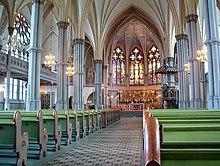
In the years 1802-1815 the Gothenburg Cathedral was built. In 1806 the fortifications were razed . What has been preserved is the former moat with its green spaces in the former glacis area , such as the horticultural association's private park with its palm house , the largest in Northern Europe.
After Napoleon's fall (1815), the French blockade ceased and Gothenburg's boom as a trading city began to fade. Many companies went bankrupt and trade with the East Indies broke off. Economic impetus, not least for industry, came from the construction of the Göta Canal , a connection to the Baltic Sea via the large freshwater lakes Vänern and Vättern, which began soon after the end of the blockade period . Because of the height difference of around 100 m, numerous locks were necessary.
In the further course of the 19th century, several banks were founded in the city, which had a positive impact on economic development. In addition, a flourishing shipyard industry developed in the middle of the 19th century (1841: Götaverken , 1844: Lindholmen , 1850: Eriksberg ). Since 1874 a large iron swing bridge connected Gothenburg over the Göta älv with the island of Hisingen.
At the end of 1884, Gothenburg had 86,223 inhabitants, including over 1000 Germans. This German colony built the Christinenkirche in the city center , which is still known today as the German Church.
20th century
In the 20th century the port of Gothenburg developed into the largest export port in Northern Europe. The city's newly founded, internationally oriented industrial companies certainly contributed to this.
The strongest economic power, however, came from the company Gamlestadens Fabrikers AB , a textile company that in 1900 had over 1,000 employees . The creation of companies like SKF was responsible for the industrial growth of Gothenburg in the first decade . The starting point for its development was again Gamlestadens Fabrikers AB, who had the problem that the underground of the factory building sank and cracked due to the clay soil. As a result, the ball bearings in the looms rubbed off at an angle. The young engineer Sven Gustaf Wingqvist then designed the self-aligning ball bearing as a solution to this problem. A separate company, AB Svenska Kullagerfabriken, or SKF for short , was founded in 1906 for this production and quickly developed into a large company in the Swedish export industry. During the financial crisis of the 1920s, the demand for rolling bearings fluctuated. To find a new market, SKF began manufacturing automobiles under the Volvo name in 1926 .
Gothenburg's shipyards were an important economic factor in the city until the 1970s. Then, however, there were serious industrial upheavals, which particularly affected the shipyards . In the so-called shipyard crisis , the shipyards were no longer able to hold their own against international competition, so that shipbuilding in Gothenburg was given up. The large shipyards were closed or limited themselves to the maintenance of ships.
Despite some big names like Viktor Rydberg and Wilhelm Stenhammar , Gothenburg was traditionally not exactly known as a cultural city; a proverb said: “You don't write poetry in Gothenburg; you write bills. "
Since the end of the 20th century, Gothenburg has developed into a place for major sporting and political events. In 1995 the city hosted the World Athletics Championships and in 2006 the European Athletics Championships took place here.
In 1976, a large number of environmental activists occupied Königsplatz (Kungstorget) for a week to defend themselves against the construction of a parking garage under this square. The Social Democrats eventually gave in, and the underground parking garage was not built.
21st century
An EU summit took place in Gothenburg from June 14-16, 2001 , during which George W. Bush was the first US President to visit Sweden. The summit was overshadowed by violent protests.
coat of arms
The coat of arms of Gothenburg consists of two elements of the large imperial coat of arms . On the one hand, it shows the lion of Götaland as a so-called imperial lion with a drawn sword as a common figure . On the other hand, the lion carries the shield of the kingdom "Svea" (three golden crowns on a blue background).
It is worth noting that contrary to the rules of heraldry , the lion is aligned to the left. The coat of arms in this form has existed since 1952 and is used by all authorities with a resolution of 2002.
Three silver wavy bars slanted to the left in blue . A left turned-over golden red gezungter and reinforced doppelschwänziger lion with golden crown oscillates with the right paw a golden sword and keeps the other a blue shield with three (2: 1 provided) golden crowns.
Attractions
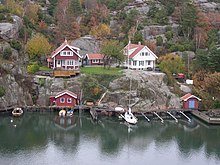
Today Gothenburg is a cultural center with a big city atmosphere, which contrasts clearly with the largely rural surrounding area. As a relic of the original fortress, there are numerous small navigable canals and old buildings in the center.
As a tourist, it is best to move around the city on foot or by bike, especially around Järntorget in the west of the city center .
Gothenburg is known for its vibrant and diverse coffee house culture. The old district of Haga offers numerous opportunities to experience this. The Vasa district has an upper- class ambience that is slightly reminiscent of Vienna's Ringstrasse buildings .
In the center is Gustav Adolfs Torg with a monument to the city's founder and buildings worth seeing. The Kronhuset is the oldest preserved building in the city, it was built in the middle of the 17th century. The entire inner city is classified as a Reich interest. The Feskekörka (1874) on Wallgraben is a fish market hall built in the style of a Gothic church.
In the harbor Lilla Bommen the largest built in Scandinavia is Windjammer , the four-masted barque Viking moored firmly (built in 1906) and serves as a hotel and museum ship .
In the immediate vicinity are the opera house ( Göteborgsoperan ) , which was inaugurated in 1994, with its imposing facade and the museum ships in Göteborgs maritima centrum .
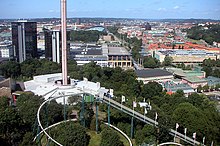
The area around the Kungsportsavenyn , at the end of which is the Götaplatsen , the cultural center of the city with its statue of Poseidon (1931), the most famous landmark of the city, has a noble effect . The Konstmuséet , the Konserthuset and the Stadsteatern are also located on the square .
Liseberg , the largest amusement park in Scandinavia, is centrally located in the city. Next to it is the Universeum , a natural science museum with an aquarium and a troparium .
The Scandinavium is a multifunctional arena. It can accommodate up to 14,000 people.
The Slottsskogen is a park 2 km southwest of the city center. There is an animal enclosure with native wild animals, including an elk family. The Natural History Museum is also located in Slottsskogen . Gothenburg also has a city museum , a maritime museum , the Emigranternas Hus and the Röhsssche Museum (Röhsska museet) , Sweden's only special museum for design and handicrafts.
The Brudaremossensender , one of the few partially guyed towers in the world, is located in the nature and leisure area Delsjöområdet .
Economy and Infrastructure
The establishment of companies such as SKF (1906) with the manufacture of rolling bearings was an important step in the industrial growth of Gothenburg . SKF then began manufacturing automobiles under the Volvo name in 1926 , now the largest in Gothenburg.
Gothenburg's shipyards were an important economic factor in the city until the 1970s. In the so-called shipyard crisis , the shipyards were no longer able to assert themselves against international competition, especially from Southeast Asia, so that shipbuilding in Gothenburg was given up. The large shipyards were closed or limited themselves to the maintenance of ships. In the meantime, a new export line with connections to many globally important petrochemical locations has developed from plant engineering and system consulting .
traffic

Port and shipping
The port of Gothenburg is Northern Europe's largest export port and is ice-free all year round. In 2016, almost 41 million tons of goods were handled here, including 246,000 vehicles. The handling of containers in Scandinavia's largest container port fell by 3% to 798,000 TEU . 23.7 million t of goods for energy generation were handled. In RoRo -Transport 538,000 units were handled; In 2017 it was 593,000, in 2018 584,000. More than half of this rolling load - often forest products (wood) - comes from traffic with the Belgian ports of Zeebrugge and Ghent . The operator of the port is the municipal Port of Gothenburg (Göteborgs Hamm AB) , there are also three private terminal operators.
From the port of Gothenburg, the local shipping company Stena Line offers ferry lines to Denmark ( Frederikshavn , several departures daily) and to Germany ( Kiel , daily departures). The number of passengers was 1.708 million in 2016, in addition to the ferries , there were 34 calls by cruise ships .
Ferries run from Saltholmen in the south-west of the city to the offshore archipelago. The islands in the southern archipelago belong to the municipality of Gothenburg and are served by Styrsöbolaget ferries on behalf of Västtrafik . The northern archipelago is part of the municipality of Öckerö and is served by a Vägverket car ferry .
railroad
Gothenburg is an important railway junction; The main railways from Oslo , Stockholm and Malmö or Copenhagen meet at Göteborg C Central Station . There is a S-Bahn- like Pendeltåg for local transport to the surrounding communities .
Bus transport
The Nils Ericson Terminal is Gothenburg's bus station . From there, both local public transport buses and national and international long-distance buses run .
tram
Besides Norrköping and Stockholm, Gothenburg is the only city in Sweden that kept its tram ( Swedish : Göteborgs spårvägar ) when it switched to right-hand traffic in 1967 (Dagen H). Today there are a total of 13 tram lines in the city. Since large parts of the city center are closed to private motorized traffic (except for residents and suppliers), the tram is also the preferred mode of transport for Gothenburg residents.
Road traffic
Since 2000, the city's infrastructure has been heavily rebuilt as part of the “Göken” project ( Göteborgsöverenskommelsen = Göteborg Agreement; literally translated as “cuckoo”). Along the harbor, the road will be laid in a tunnel to create a large park. This is the largest construction project in the city.
Air traffic
The city of Gothenburg has two airports. East of the city is the Landvetter flygplats at Riksväg 40 , with many national and international connections. The Gothenburg / Säve airport is located north of the city in Säve, he was until 2015 mainly by low cost airlines fly before the operation has been reduced.
education
Gothenburg is home to two universities: the Gothenburg State University, founded in 1891, and the Chalmers University of Technology (founded in 1829), which is run by a foundation .
The University of Gothenburg is one of the largest universities in Scandinavia. It includes a business school ( Handelshögskolan ) and an art school called Valand .
Chalmers University of Technology is primarily the center of technical and scientific education in Gothenburg, although there are also various technically oriented study programs at Gothenburg University. A joint project between the two universities is the IT university , which was established in 2001 and focuses on IT-relevant training areas.
Established businesses
The industry of Gothenburg today is characterized by shipping, shipyards , car factories ( Volvo ), oil refineries and the machine, steel, iron and textile industries. Gothenburg is one of the most important trade fair cities in Europe. The city is the seat of many banks and insurance companies.
Resident companies include:
- AstraZeneca (pharmaceutical industry)
- Ericsson (founded 1876, telecommunications)
- ESAB (founded in 1904, mechanical engineering (especially welding and cutting technology))
- Ewellix (formerly SKF Moton Technologies)
- Hasselblad (founded 1908, optical industry)
- PowerCell (founded in 2008, developer and manufacturer of fuel cells )
- Saab (Svenska Aeroplan Aktiebolaget, founded in 1937, car, truck and aircraft manufacturer)
- Stena Line (ferry company)
- SKF (Svenska Kullager Fabriken, founded 1907, metal industry)
- Volvo AB (headquarters of the group of companies; commercial vehicle production, buses, boat engines)
- Volvo Car Corporation (car manufacturer)
- Banan company since 1909
Culture
The Gothenburg Symphony Orchestra has had the official title of "National Orchestra of Sweden" for several years. Under their long-standing (1982–2004) chief conductor Neeme Järvi , the Symphoniker made numerous internationally recognized recordings, primarily of Scandinavian music.
The Gothenburg Opera House , located on the south bank of the Göta älv , was inaugurated in 1994. It has its own opera, ballet and musical ensembles.
Gothenburg is home to a global metal scene known as Gothenburg Death Metal . The bands In Flames , Dark Tranquility and At the Gates should be mentioned as pioneer bands .
The Gothenburg Book Fair , the largest book fair in Scandinavia, takes place every September. And since 2013 there has been a literary house in Göteborgs Lagerhus , today under the name Göteborgs Litteraturhus .
The Gothenburg International Film Festival , the largest film festival in Scandinavia, takes place annually.
Göteborgs konstmuseum is one of the largest art museums in Sweden.
Göteborgs Konsthall is a center for contemporary art and a partner of the Gothenburg Biennale .
religion
The majority of the population traditionally belong to the Lutheran Church of Sweden .
Since 1862 there has also been a Roman Catholic parish again. Its center is the Christ the King Church, built in 1937/38 .
At the foot of the Ramberget is the Gothenburg mosque, financed by Saudi Arabia . The Salafist Bellevue Mosque is located on Generalsgatan in the Bellevue district of Gothenburg.
Gothenburg in literature
Gothenburg is the setting for Åke Edwardson's crime novels ( The Shadow Woman , The Last Evening of the Season , Heaven on Earth and others), in which Commissioner Erik Winter investigates, as well as the crime novels by Helene Tursten , which Inspector Irene Huss has written in ten novels so far can be determined.
Gothenburg also forms the background of Marianne Fredriksson's novel Simon , which is a study of Gothenburg's milieu between 1930 and 1950. It tells the story of two families from the perspective of adolescents before, during and after the Second World War in neutral Sweden.
Sports

Gothenburg is home to the most successful Swedish men's football club, IFK Göteborg , with 18 national championships, four national cup wins and two UEFA Cup victories . In addition, the BK Häcken also plays in the first division. The football clubs GAIS and Örgryte IS are also popular in the city. Both are currently playing in the second and third leagues.
The Frölunda Indians ice hockey team won four Swedish championships (1965, 2003, 2005, 2016). The volleyball club Gråå BK plays in the third division.
Year after year, Gothenburg is the venue for the Partille Cup , the largest handball tournament in the world, in which around 10,000 young players of all ages participate in 800 teams from 40 nations. The biggest event every summer is the Gothia Cup , with tens of thousands of children and young people taking part in the international soccer tournament.
Sporting events

- In 1958, Gothenburg was the venue for the semi-finals of the 6th World Cup . The legendary semi-final between Sweden and the Federal Republic of Germany 3: 1 (1: 1) took place there on June 24th .
- In 1992 Gothenburg hosted the European Football Championship . Among other things, the final took place on June 26th in the Ullevi Stadium , in which Denmark defeated the German team 2-0 (1-0).
- The 1995 World Athletics Championships were held in Gothenburg,
- In 1999, the U23 European Athletics Championships took place.
- In 2005, the European team championship in chess took place in the city.
- From August 6th to 13th, 2006, Gothenburg hosted the 19th European Athletics Championships .
- The final of the Speedway Individual World Championship made several stops in the Ullevi Stadium . From 2008 to 2013 Gothenburg was the site of the Grand Prix series as part of the Speedway Individual World Championship.
- The Gothia Cup , an international soccer tournament for young people, has been held every summer since 1975 .
- Once a year, since 1980, the Göteborgsvarvet half marathon takes place in May .
- Gothenburg hosted the World Figure Skating Championships in 1976 and 2008 . The European championships took place in the city in 1972 , 1980 and 1985 .
- The final of the Show Jumping World Cup was first held in Gothenburg in 1979. This was followed in 1982, 1986, 1988, 1991, 1993, 1995, 1997, 1999, 2001, 2008, 2013, 2016 and 2019. All events were held in the Scandinavium . The next final is to be held in the Swedish city in 2021.
- In 2011 the 22nd men's handball world championship took place. Here Gothenburg was one of the venues with the Scandinavium, a multi-purpose hall with a capacity of almost 12,000 people.
- In July 2013, four European Women's Football Championship matches were played in Gothenburg .
- In 2021, the 2020/21 UEFA Women's Champions League final is to be played at the Gamla Ullevi stadium. The UEFA took the 400th anniversary of the city's foundation as a reason for the award.
Town twinning
Gothenburg lists the following seven twin cities :
| city | country | Type | since |
|---|---|---|---|
| Aarhus |
|
Vanort | 1946 |
| Mountains |
|
Vanort | 1946 |
| Chicago |
|
Twin town | 1987 |
| Lyon |
|
Twin town | 1990 |
| Nelson Mandela Bay |
|
Twin town | 1998 |
| Shanghai |
|
Twin town | 1986 |
| Turku |
|
Vanort | 1946 |
sons and daughters of the town
literature
- Robert Schediwy: City Images - Reflections on Change in Architecture and Urbanism , Lit, Vienna 2005 (especially p. 95 ff.)
Web links
- Official website of the city (English, Swedish)
- Official tourist information (German and others)
Individual evidence
- ↑ a b c d Statistiska centralbyrån : Land area per crime scene, folkmängd and invånare per square kilometer. Vart femte år 1960 - 2015 (database query)
- ↑ Folkmängd i riket, län och communer 30 September 2016 och befolkningsförändringar 1 July – 30 September 2016 ( Memento of the original from November 12, 2016 in the Internet Archive ) Info: The archive link was inserted automatically and has not yet been checked. Please check the original and archive link according to the instructions and then remove this notice.
- ↑ Statistiska centralbyrån : perpetrators 2015 som delas av commungräns (Excel file)
- ↑ Göteborgsbladet 2016 (Swedish)
- ↑ WMO
- ↑ wetterkontor.de
- ↑ Stadsvapnets historia on the city's website (Swedish)
- ↑ Riksantikvarieämbetet: Riksintressen för kulturmiljövården. ( Memento of the original from May 16, 2012 in the Internet Archive ) Info: The archive link was inserted automatically and has not yet been checked. Please check the original and archive link according to the instructions and then remove this notice.
- ↑ Go: teborg.com. Retrieved May 25, 2020.
- ↑ Peter Kleinort: Gothenburg benefits from car transshipment · Energy sources are also increasing · Decline in containers and passengers . In: Daily port report of February 15, 2017, p. 13.
- ^ André Germann: Gothenburg relies on RoRo traffic · Ghent and Zeebrugge play a key role. In: Daily port report of November 27, 2018, p. 14
- ↑ Gothenburg's Moské
- ↑ Final of the Women's Champions League 2021 in Gothenburg. In: de.uefa.com. UEFA , May 29, 2019, accessed June 1, 2019 .
- ↑ Internationellt samarbete - Göteborgs Stad. Retrieved May 29, 2017 .


